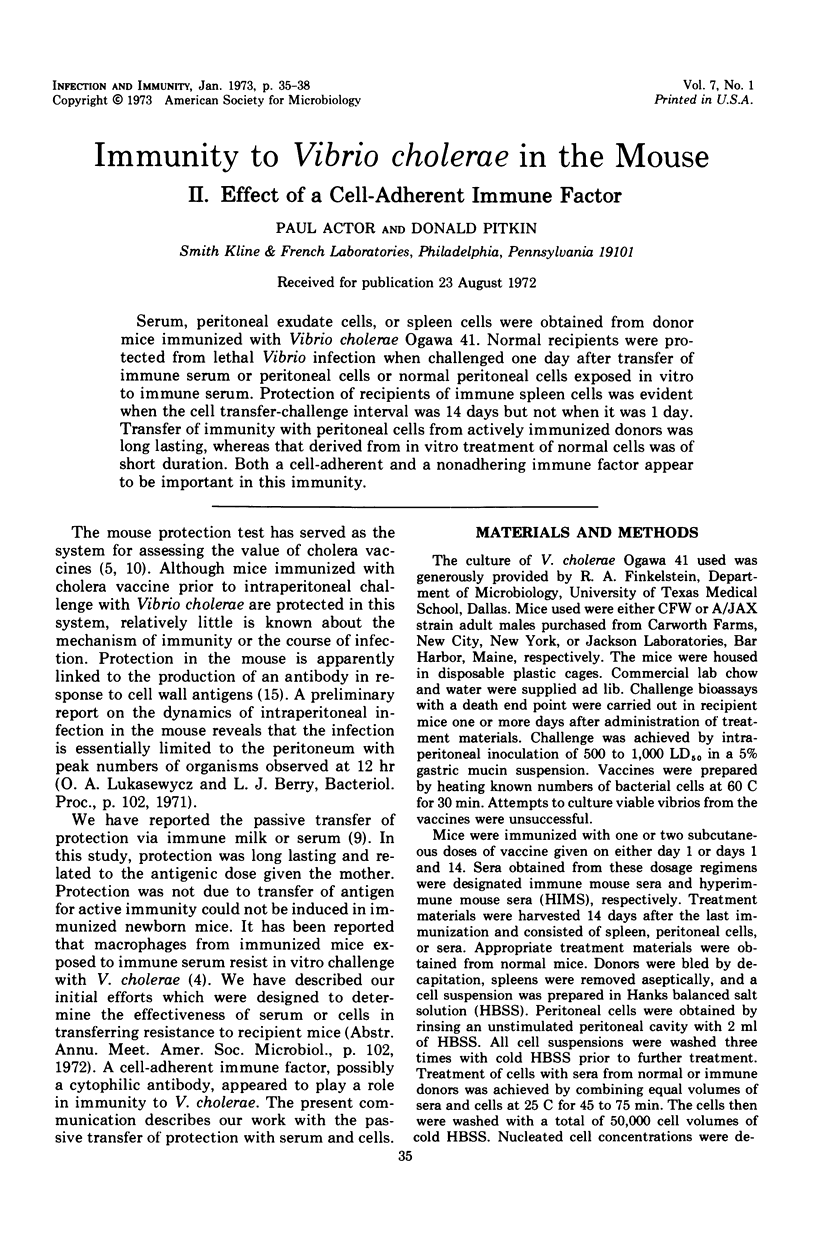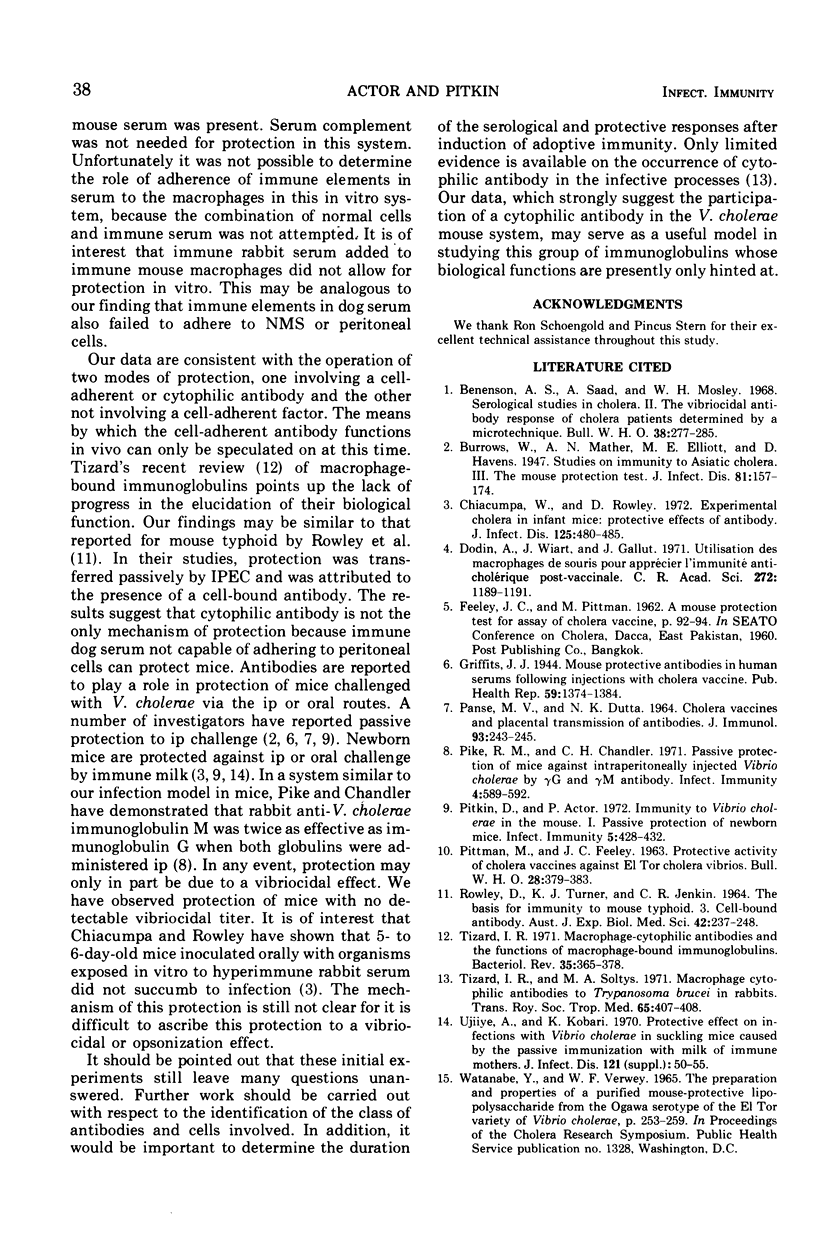Abstract
Serum, peritoneal exudate cells, or spleen cells were obtained from donor mice immunized with Vibrio cholerae Ogawa 41. Normal recipients were protected from lethal Vibrio infection when challenged one day after transfer of immune serum or peritoneal cells or normal peritoneal cells exposed in vitro to immune serum. Protection of recipients of immune spleen cells was evident when the cell transfer-challenge interval was 14 days but not when it was 1 day. Transfer of immunity with peritoneal cells from actively immunized donors was long lasting, whereas that derived from in vitro treatment of normal cells was of short duration. Both a cell-adherent and a nonadhering immune factor appear to be important in this immunity.
Full text
PDF



Selected References
These references are in PubMed. This may not be the complete list of references from this article.
- Benenson A. S., Saad A., Mosley W. H. Serological studies in cholera. 2. The vibriocidal antibody response of cholera patients determined by a microtechnique. Bull World Health Organ. 1968;38(2):277–285. [PMC free article] [PubMed] [Google Scholar]
- Chaicumpa W., Rowley D. Experimental cholera in infant mice: protective effects of antibody. J Infect Dis. 1972 May;125(5):480–485. doi: 10.1093/infdis/125.5.480. [DOI] [PubMed] [Google Scholar]
- Dodin A., Wiart J., Gallut J. Utilisation des macrophages de souris pour apprécier l'immunité anticholérique post-vaccinale. C R Acad Sci Hebd Seances Acad Sci D. 1971 Feb 22;272(8):1189–1191. [PubMed] [Google Scholar]
- PANSE M. V., DUTTA N. K. CHOLERA VACCINES AND PLACENTAL TRANSMISSION OF ANTIBODIES. J Immunol. 1964 Aug;93:243–245. [PubMed] [Google Scholar]
- PITTMAN M., FEELEY J. C. Protective activity of cholera vaccines against E1 Tor cholera vibrios. Bull World Health Organ. 1963;28(3):379–383. [PMC free article] [PubMed] [Google Scholar]
- Pike R. M., Chandler C. H. Passive protection of mice against intraperitoneally injected Vibrio cholerae by G and M antibody. Infect Immun. 1971 Nov;4(5):589–592. doi: 10.1128/iai.4.5.589-592.1971. [DOI] [PMC free article] [PubMed] [Google Scholar]
- Pitkin D., Actor P. Immunity to Vibrio cholerae in the mouse. I. Passive protection of newborn mice. Infect Immun. 1972 Apr;5(4):428–432. doi: 10.1128/iai.5.4.428-432.1972. [DOI] [PMC free article] [PubMed] [Google Scholar]
- ROWLEY D., TURNER K. J., JENKIN C. R. THE BASIS FOR IMMUNITY TO MOUSE TYPHOID. 3. CELL-BOUND ANTIBODY. Aust J Exp Biol Med Sci. 1964 Apr;42:237–248. doi: 10.1038/icb.1964.25. [DOI] [PubMed] [Google Scholar]
- Tizard I. R. Macrophage-cytophilic antibodies and the functions of macrophage-bound immunoglobulins. Bacteriol Rev. 1971 Dec;35(4):365–378. doi: 10.1128/br.35.4.365-378.1971. [DOI] [PMC free article] [PubMed] [Google Scholar]
- Tizard I. R., Soltys M. A. Macrophage cytophilic antibodies to Trypanosoma brucei in rabbits. Trans R Soc Trop Med Hyg. 1971;65(3):407–408. doi: 10.1016/0035-9203(71)90029-0. [DOI] [PubMed] [Google Scholar]
- Ujiye A., Kobari K. Protective effect on infections with Vibrio cholerae in suckling mice caused by the passive immunization with milk of immune mothers. J Infect Dis. 1970 May;121(Suppl):50+–50+. doi: 10.1093/infdis/121.supplement.s50. [DOI] [PubMed] [Google Scholar]


